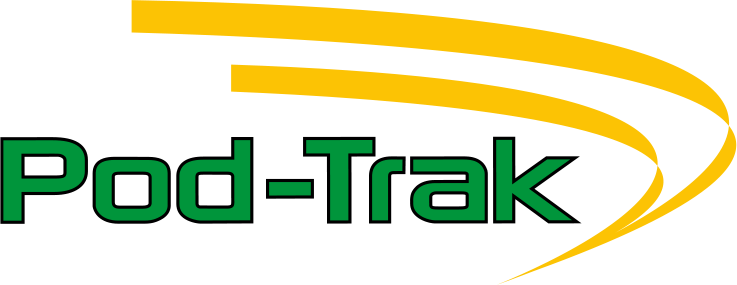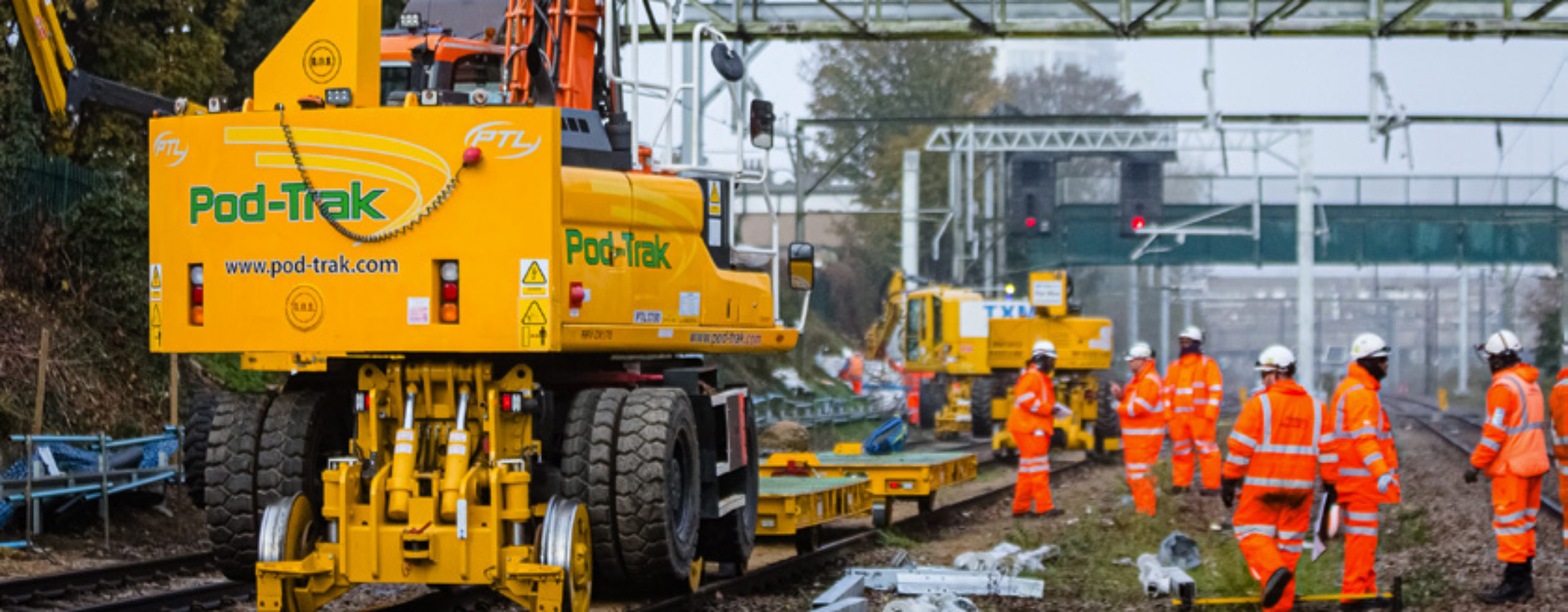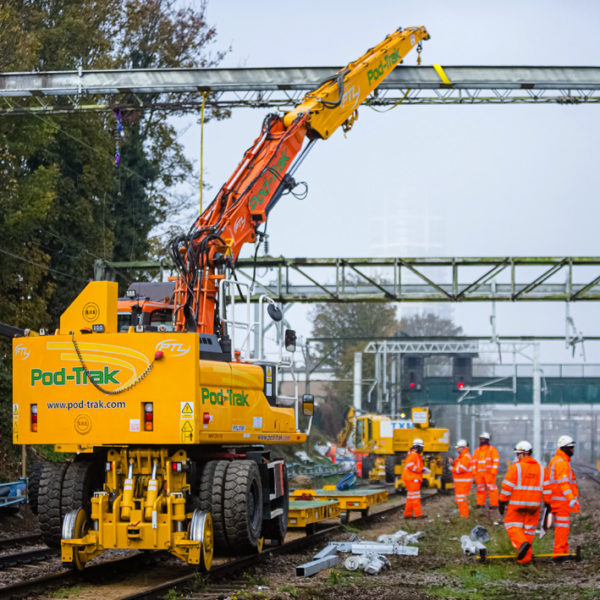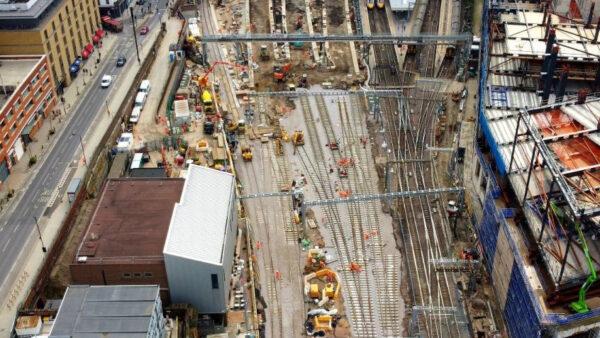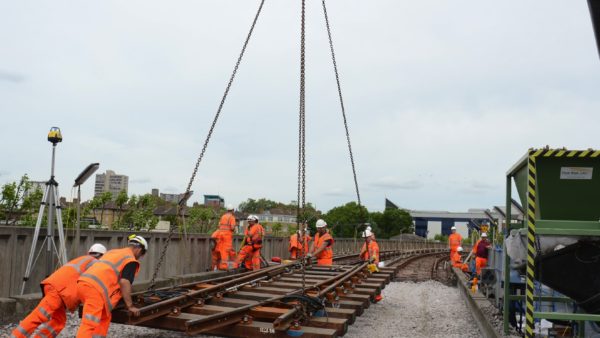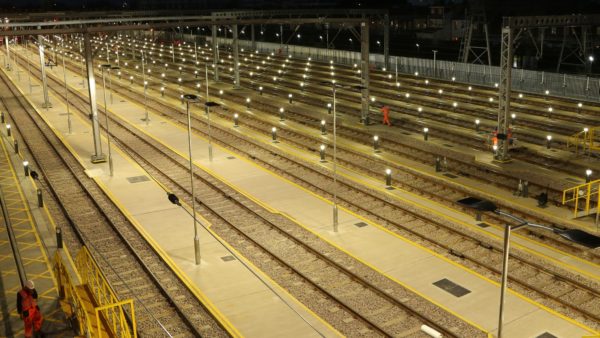Project Overview
To support the development of 10,000 new homes in East London as part of the Barking Riverside Development, a new station was built and the London Overground was extended into the new Station. In addition to the new infrastructure, significant work was delivered to remodel the existing railway
infrastructure.
Our Role
Pod-Trak were contracted by MSVF JV as the multidiscipline Permanent Way and OLE specialist to deliver all the track and OLE scope. Due to the nature of the works and the size of the packages our team were based on site with the JV to ensure a collaborative approach and efficient delivery of the works.
Scope of Works
The multidiscipline scope covered three key areas;
- A 4.5km extension to the new Barking Riverside Station
from the Tilbury Loop Line between Barking and
Dagenham Dock Stations. - Reconfiguration of Network Rail’s Ripple Lane Goods
Yard to allow the extension to connect to the Tilbury Loop. - Continuation of the Rail Systems over a new 1.5km slab
track viaduct into the heart of Barking Riverside.
The OLE scope consisted of the following items;
- Electrification of the Up and Down Barking Riverside
Extension. - Installation of 610mm dia piles and all main steel.
- Installation of cantilevers, SPS and catenary wires.
- Installation of Neutral Sections and Section Insulators
- Installation of new OLE switches.
- Modifications to and renewal of existing infrastructure.
- Modifications to the Barking FS and Purfleet MPTSC circuit breaker configurations.
- Bonding connections required for bonding between the existing Mark 3 OLE System with RC and EW and the new Series 2 OLE System with RSC and AEW.
- Traction Return Bonding in line with the S&T staging.
- All Section Proving and Testing & Commissioning.
The Permanent Way scope consisted of the following items;
- Installation of a new double track spur line on the viaduct circa 1km.
- Installation of 6km of new ballasted track in various stages.
- Remodelling of Ripple Lane sidings including numerous abandonments of S&C.
- Transition section between ballast and slab track (VTRAS).
- Installation of new crossovers & turnouts totalling 12nr point ends, 4nr crossovers & 4nr turnouts of varying geometry.
- Track lubrication and buffer stops.
- Welding and stressing using both Alumino Thermic and Flashbutt welding techniques.
- Critical Rail Temperature (CRT) Management and Track Monitoring.
Delivering Expertise
Being a multidisciplinary project, it was a critical requirement for Pod-Trak to adopt a fully integrated planning and delivery process, commencing at the pre-construction stage, which continued throughout delivery to project completion. The delivery of the project was undertaken in pre-planned Network Rail possessions for efficient access throughout the worksite utilising engineering trains for the removal of arisings and the delivery of materials.
The Pod-Trak team were key in the staging of the works as both the Permanent Way & OLE programmes were reliant on the possession & engineering train schedule which fed in to the signalling design through the project integration meetings, IDC & IDR meetings with our respective CRE-C’s. A project deliverable set by Network Rail and TfL for the delivery of the works was to ensure both the main lines and the sidings were operational throughout the project which meant track handback was critical after each possession. In line with NR standards a comprehensive follow up works
programme was incorporated into the programme to ensure all tamping, welding and stressing activities were completed on time and to minimise the requirement for supplementary inspections and monitoring. A staged handback of all completed works was vital to ensure Pod-Trak met key programme milestones. The team implemented and ensured handover documentation was completed progressively throughout the project in conjunction with MSVF. Like many projects delivered during this period, the impact of Covid-19 on the overall project programme meant some works had to be replanned and moved to later possessions.
The knock on effect of this required a huge effort from all stakeholders to ensure and integrated programme could still be produced and key interfaces between disciplines were managed accordingly.
Being a self-delivery business, all plant required for the delivery of the works was provided by our Plant Division including all POS & ALO Planning and Management. Over the course of the project our Plant Division supported the project by providing;
- Road Rail MEWPS
- Road Rail Excavator Cranes
- Road Rail Dozers
- Civils Plant
- Specialist lifting equipment for OLE (Pull lifts, slings, rollers etc)
- Specialist track tools
Engineering and monitoring equipment - Transport
Plain Line Track Renewals
- Design Validation & setting out ahead of each mobilisation
- Detailed train planning and deconfliction planning with the Anglia planning team
- Preparation works for LWRT, then delivery of LWR using the LWRT
- Engineering trains utilised for scrap panels, spoil, ballast, and new sleepers
- Varied P/L renewals Cat 11, Cat 4 SSR and Cat 14 Formation LSR
- Scrapping out in 30’ panels & loading to Osprey or Salmon wagons
- Excavating to required design depth below sleeper bottom using PC128s and Laser Dozer, with 3D and 2D control of excavation
- Offloading bottom ballast using PC128s, levelling with Laser Dozer before compacting using Triple Whacker
- Sleepers installed using hydraulic sleeper spreader attached to PC128s
- New LWR thimble onto new sleepers using Doosan RRV c/w Drag Clamp & Thimble
- Install temp clamped joints & clipping up using Robel Clippers, Pandrol & fast clip inserters as required
- Top stone unloaded (Falcon Wagons) using Doosan RRV and profiling ready for tamper
- Our Engineer collated the as built information and loaded the geometry and Versch files to the tamper which implemented the new track design
- Profiling and brushing following the tamper.
- Welding and stressing as required using both Alumino thermit and Flashbutt welding techniques
S&C Renewals
As per Plain Line with the addition of:
- Multiple Inspections at Progress Manufacturers Yard.
- Prefabrication of S&C in panel form undertaken in two ways – (1) for the Kirow with no welding completed in advance or (2) for PEM/LEM with as many lineside welds
completed in advance saving on follow up access - Abandonments and plain lining existing S&C efficiently utilising materials on site temporarily.
OLE Installations
- Design Validation and technical query implementation
- Setting out for pile installation
- Pile verification for across-track measurements prior to main steel procurement
- Strategic procurement and deliveries of materials to mitigate storage areas
- Where possible multiple RRVs used to install main steel to achieve maximum output and reduce temporary bonds
- Site clearance in hour-by-hour programmes to ensure all redundant structures are removed from the infrastructure, cut into manageable lengths and placed in specific skips for waste transfer.
- Strategic procurement and deliveries of Conductors to mitigate potential theft and congested storage areas
- Planned and integrated exclusion zones agreed prior to possessions to ensure all disciplines have access
- Quality check sheets compiled for each element of work as installed in line with the ITP to achieve a sustained handback process.
- Section proving and commissioning strategy agreed with all stakeholders in advance to ensure blockers are resolved
Continuous Improvement
Milestone reporting throughout 50-hour possessions was being questioned regularly due to slippage in shifts 1 and 2. It soon became apparent, that the delays were the time it was
taking to sign all resources in with the SAC and the COSSs with the Engineering Supervisor and Nominated Person. To mitigate this, we agreed to stagger shifts with all disciplines to remove congestion with signing in and introduced signing out by text.
